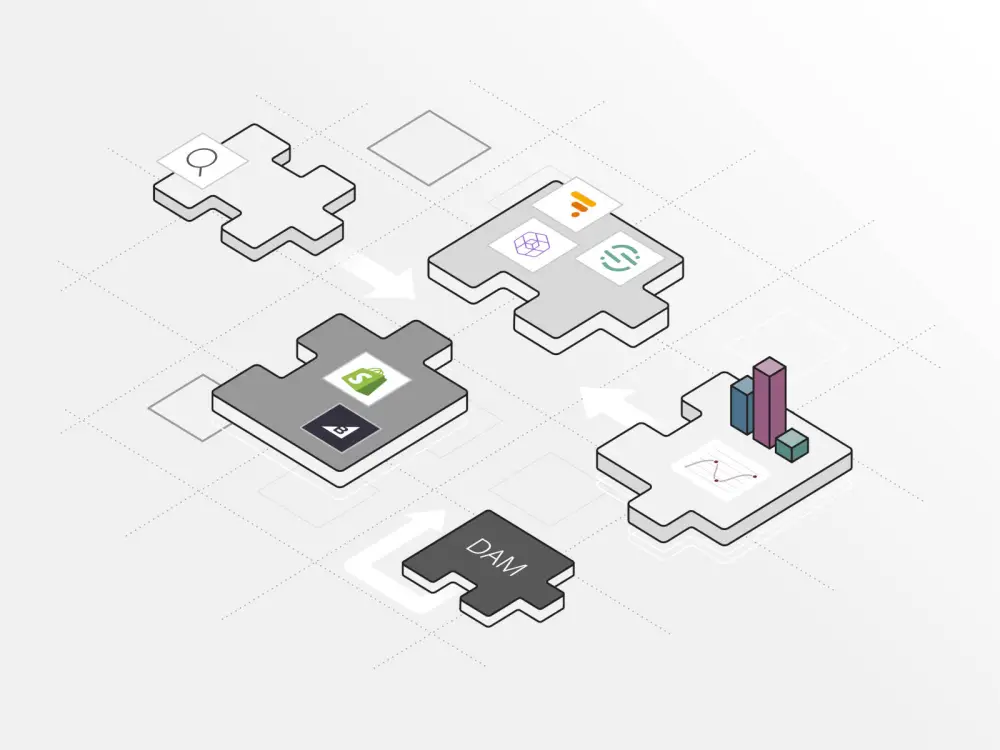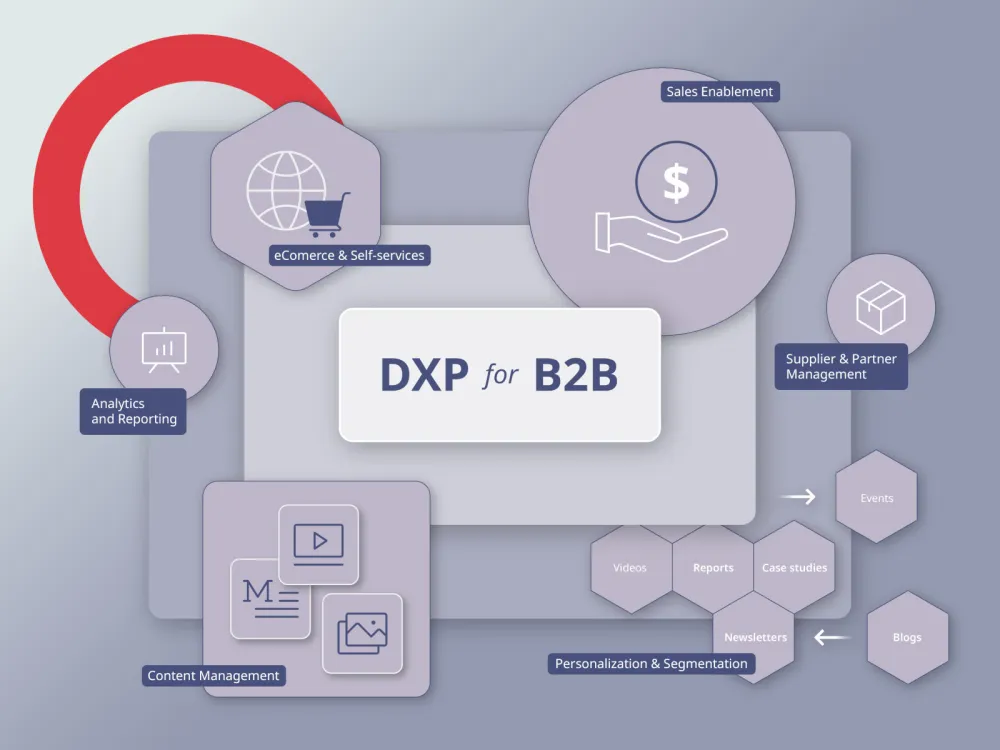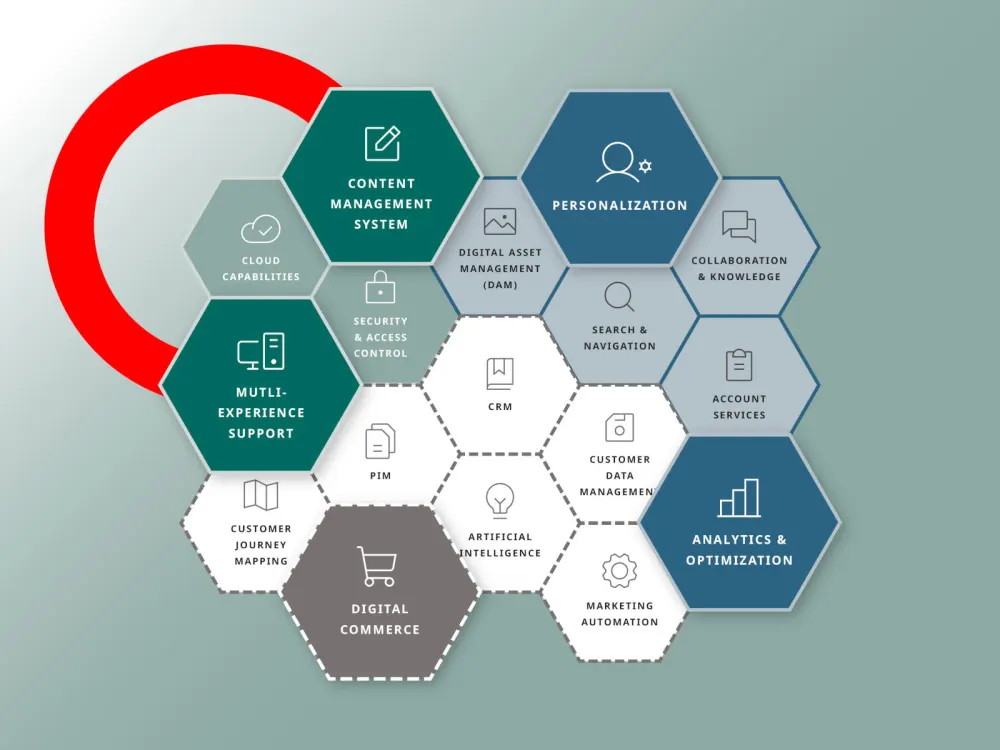As companies of all types and sizes strive to create digital experiences with prospects and customers, the idea of creating a digital experience platform has become increasingly popular. While most organizations can agree on the need to foster positive experiences with customers through a variety of channels, there are a number of different opinions about how to accomplish that. Understanding the components of a digital experience platform and how to create the one that will work best for your organization is the best way to start.
What is a digital experience platform (DXP)?
A digital experience platform (DXP) is a group of core technologies that are integrated to support the development, management and delivery of digital experiences. Together, these technologies allow companies to create, host and distribute digital experiences across multiple channels and devices.
Today’s customers expect to be able to have connected experiences with a brand through various channels and devices, and a digital experience platform makes that possible. For example, a community bank might advertise a no-fee checking account on social media to local users. A potential customer might interact with the ad on Facebook from their work computer, click through to the bank’s website and read some articles about personal finance. The customer may provide their email address to get more personal finance advice, and after receiving some relevant emails, they sign up for an account. Later, the customer might download the bank’s mobile app to track their account balance or set up a direct deposit. The app will then send notifications to the customer’s smartphone and smartwatch to alert them of changes to their account.
In the past, it would have been overwhelming for a small bank to create and manage all these different experiences in a connected, relevant way. But digital experience platforms make it manageable and even seamless.
What components should be included in a digital experience platform?
The word “platform” sounds like a DXP is one product that contains all the tools you need to create and manage digital experiences, but that’s not necessarily the case. There are some standalone DXP suites, but it’s difficult to find one platform that can effectively meet the needs of most organizations. As a result, most companies design their own digital experience platforms by combining the technology tools they need. Typically, a digital experience platform will include the following components:
- Content management system (CMS). Content is at the heart of every digital experience, and customers expect to have connected content experiences across a number of channels on all their devices. While a traditional CMS- managed content for a single channel, such as a website or app, a headless CMS makes it possible to create, store and manage content in one location, to be deployed to any device or channel. A headless CMS can separate how content is created and managed from how it is delivered and displayed. That means pushing the same content—or parts of the same content—to a website, app, wearable device, and smartphone is easy and seamless.
- Analytics tool. Creating, publishing and managing a large volume of content is pointless without data analytics, which can show you which types and pieces of content are gaining traction and which ones are not resonating with your audience. Some content management systems, including Brightspot, include analytics capabilities. Brightspot, for example, has its own analytics capabilities out of the box, and it also integrates seamlessly with third-party analytics providers such as Google Analytics.
- Personalization product. For most companies, building the right digital experience platform must include the ability to personalize content for individual users. Consider a CMS that includes built-in personalization tools for audience targeting and segmentation, or choose an add-on product to enhance your digital experience with personalization.
- Digital asset management. Digital asset management software integrates artificial intelligence and machine learning technology to make all your digital assets easy to discover, manage and share across platforms and with your partners.
A digital experience platform (DXP) is a software solution that helps companies provide engaging, personalized experiences across multiple digital touchpoints. It enables businesses to create, manage, optimize and deliver content and experiences to customers, partners and employees in a seamless and cohesive way. DXPs typically include a variety of tools and capabilities, such as content management, customer data management, analytics and marketing automation, all of which work together to create a consistent and personalized experience for users.
A digital experience platform (DXP) is a software solution that helps companies provide engaging, personalized experiences across multiple digital touchpoints. It enables businesses to create, manage, optimize and deliver content and experiences to customers, partners and employees in a seamless and cohesive way. DXPs typically include a variety of tools and capabilities, such as content management, customer data management, analytics and marketing automaion, all of which work together to create a consistent and personalized experience for users.
A digital experience platform (DXP) can benefit your business in several ways. It can help you provide personalized experiences for your customers, increase engagement and loyalty, improve conversion rates, streamline content creation and management, optimize marketing campaigns and gain valuable insights into user behavior and preferences. Additionally, a DXP can help you streamline your operations and reduce costs by consolidating disparate technology systems and tools.
Many well-known companies use digital experience platforms (DXPs) to power their digital experiences, including Brightspot, Sitecore, Salesforce Experience Cloud, Acquia and Episerver, to name a few. These companies operate in various industries such as retail, healthcare, financial service, and technology and have leveraged DXPs to create engaging, personalized experiences for their customers.
While a digital experience platform (DXP) and a customer relationship management system (CRM) share some similarities, they have distinct differences. A DXP is a comprehensive solution that provides tools for creating, managing and delivering personalized digital experiences, whereas a CRM is focused on managing customer relationships and sales processes. While a CRM can integrate with a DXP, a DXP provides more comprehensive functionality for delivering seamless and cohesive digital experiences.
When choosing a digital experience platform (DXP), it’s important to consider your business goals, budget, resources and technical requirements. You’ll want to evaluate a variety of criteria, such as flexibility, scalability, ease of use, integrations, customer support and security features. It’s also important to evaluate your existing technology systems and determine how a DXP will fit with your overall technology stack.
Implementing a digital experience platform (DXP) requires careful planning, execution and optimization to ensure success. Some best practices to consider include identifying clear business goals and objectives, involving stakeholders from across the organization, investing in user experience testing and optimization, taking an agile approach to development and continuously monitoring and analyzing performance metrics to iterate and improve your digital experiences. Additionally, it’s important to plan for ongoing maintenance and support to ensure your DXP is up-to-date and secure.
The right CMS is a core component of a successful digital experience platform. Contact us today to learn how Brightspot publishing power, flexibility, customizable foundation and integration readiness make it a natural DXP solution.











